Moon Face
The patient below has the characteristic moon face of a disorder named Cushing’s syndrome. Other signs and symptoms of this disorder include abnormal weight gain, acne, and excessive hairiness, among many other abnormalities. What can cause so many different problems in one patient? The answer is the overproduction of the endocrine system hormone cortisol.

Overview of the Endocrine System
The endocrine system is a system of glands called endocrine glands that release chemical messenger molecules into the bloodstream. The messenger molecules of the endocrine system are called endocrine hormones. Other glands of the body, including sweat glands and salivary glands, also secrete substances but not into the bloodstream. Instead, they secrete them through ducts that carry them to nearby body surfaces. These other glands are not part of the endocrine system. Instead, they are called exocrine glands.
Endocrine hormones act slowly compared with the rapid transmission of electrical messages by the nervous system. Endocrine hormones must travel through the bloodstream to the cells they affect, and this takes time. On the other hand, because endocrine hormones are released into the bloodstream, they travel throughout the body wherever blood flows. As a result, endocrine hormones may affect many cells and have body-wide effects. The effects of endocrine hormones are also longer lasting than the effects of nervous system messages. Endocrine hormones may cause effects that last for days, weeks, or even months.
Glands of the Endocrine System
The major glands of the endocrine system are shown in the figure below. The glands in the figure are described briefly in the rest of this section. Refer to the figure as you read about the glands in the following text.

Pituitary Gland
The pituitary gland is located at the base of the brain. It is controlled by the nervous system via the brain structure called the hypothalamus, to which it is connected by a thin stalk. The pituitary gland consists of two lobes, called the anterior (front) lobe and posterior (back) lobe. The posterior lobe stores and secretes hormones synthesized by the hypothalamus. The anterior lobe synthesizes and secretes its own endocrine hormones, also under the influence of the hypothalamus. One endocrine hormone secreted by the pituitary gland is growth hormone, which stimulates cells throughout the body to synthesize proteins and divide. Most of the other endocrine hormones secreted by the pituitary gland control other endocrine glands. Generally, these hormones direct the other glands to secrete either more or less of their hormones. This is why the pituitary gland is often referred to as the “master gland” of the endocrine system.
Remaining Glands of the Endocrine System
Each of the other glands of the endocrine system is summarized below. Several of these endocrine glands are also discussed in greater detail in other concepts in the present chapter.
- The thyroid gland is a large gland in the neck. Thyroid hormones such as thyroxine increase the rate of metabolism in cells throughout the body. They control how quickly cells use energy and make proteins.
- The four parathyroid glands are located in the neck behind the thyroid gland. The parathyroid hormone helps keep the level of calcium in the blood within a narrow range. It stimulates bone cells to dissolve calcium and release it into the blood.
- The pineal gland is a tiny gland located near the center of the brain. It secretes the hormone melatonin, which controls the sleep-wake cycle and several other processes. The production of melatonin is stimulated by darkness and inhibited by light. Cells in the retina of the eye detect light and send signals to a structure in the brain named the suprachiasmatic nucleus (SCN). Nerve fibers carry the signals from the SCN to the pineal gland via the autonomic nervous system.
- The pancreas is located near the stomach. Its endocrine hormones include insulin and glucagon, which work together to control the level of glucose in the blood. The pancreas also secretes digestive enzymes into the small intestine.
- The two adrenal glands are located above the kidneys. Adrenal glands secrete several different endocrine hormones, including the hormone adrenaline, which is involved in the fight-or-flight response. Other endocrine hormones secreted by the adrenal glands have a variety of functions. For example, the hormone aldosterone helps to regulate the balance of minerals in the body. The hormone cortisol, which causes Cushing’s syndrome when it is produced in excess, is also an adrenal gland hormone.
- The gonads include the ovaries in females and testes in males. They secrete sex hormones, such as testosterone (in males) and estrogen (in females). These hormones control sexual maturation during puberty and the production of gametes (sperm or egg cells) by the gonads after sexual maturation.
- The thymus gland is located in front of the heart. It is the site where immune system cells called T cells mature. T cells are critical to the adaptive immune system, in which the body adapts to specific pathogens.
What are endocrine disorders?
Endocrine disorders are diseases related to the endocrine glands of the body. The endocrine system produces hormones, which are chemical signals sent out, or secreted, through the bloodstream. Hormones help the body regulate processes, such as appetite, breathing, growth, fluid balance, feminization and virilization, and weight control.
Common endocrine disorders include diabetes mellitus, acromegaly (overproduction of growth hormone), Addison’s disease (decreased production of hormones by the adrenal glands), Cushing’s syndrome (high cortisol levels for extended periods of time), Graves’ disease (type of hyperthyroidism resulting in excessive thyroid hormone production), Hashimoto’s thyroiditis (autoimmune disease resulting in hypothyroidism and low production of thyroid hormone), hyperthyroidism (overactive thyroid), hypothyroidism (underactive thyroid), and prolactinoma (overproduction of prolactin by the pituitary gland). These disorders often have widespread symptoms, affect multiple parts of the body, and can range in severity from mild to very severe. Treatments depend on the specific disorder but often focus on adjusting hormone balance using synthetic hormones.
Modern treatment is generally quite effective for endocrine disorders, and severe consequences of endocrine dysfunction are rare. However, untreated endocrine disorders can have widespread complications throughout the body.
Diseases of the endocrine system are relatively common. An endocrine system disease usually involves the secretion of too much or not enough of a hormone. When too much hormone is secreted, the condition is called hypersecretion. When not enough hormone is secreted, the condition is called hyposecretion.
Hypersecretion

Hypersecretion by an endocrine gland is often caused by a tumor. For example, a tumor of the pituitary gland can cause hypersecretion of growth hormone. If this occurs in childhood and goes untreated, it results in very long arms and legs and abnormally tall stature by adulthood (see ). This condition is commonly known as gigantism. Martin Van Buren Bates is depicted in Figure <span id=”MathJax-Element-5-Frame” class=”MathJax” style=”display: inline-table; font-style: normal; font-weight: normal; line-height: normal; font-size: 17.6px; text-indent: 0px; text-align: left; text-transform: none; letter-spacing: normal; word-spacing: normal; overflow-wrap: normal; white-space: nowrap; float: none; direction: ltr; max-width: none; max-height: none; min-width: 0px; min-height: 0px; border: 0px; padding: 0px; margin: 0px; position: relative;” tabindex=”0″ role=”presentation” data-mathml=”12.2.3″>12.2.3
12.2.3 standing next to a man of average size. Bates was a Civil War-era American famed for his incredibly large size. He was at least 7 feet 9 inches tall and weighed close to 500 pounds. He was normal in size at birth but started to grow very rapidly by about age 6 years, presumably because of the hypersecretion of growth hormone.
Hyposecretion
Hyposecretion by an endocrine gland is often caused by the destruction of the hormone-secreting cells of the gland. As a result, not enough of the hormone is secreted. An example of this is type 1 diabetes, in which the body’s own immune system attacks and destroys cells of the pancreas that secrete insulin. This type of diabetes is generally treated with frequent injections of insulin.
Hormone Insensitivity
In some cases, an endocrine gland secretes a normal amount of hormone, but target cells do not respond normally to it. This may occur because target cells have become resistant to the hormone. An example of this type of endocrine disorder is Androgen Insensitivity Disorder. Individuals with this disorder are born with an X and Y chromosome but develop and raised as females. This is due to a mutation in the Androgen Receptor (AR) gene which is located on the X chromosome. Testosterone is an androgen hormone that causes testes to descend and typical male characteristics to develop. People with this form of the condition have the external sex characteristics of females but do not have a uterus and therefore do not menstruate and are unable to conceive a child (infertile). They are typically raised as females and have a female gender identity. Affected individuals have male internal sex organs (testes) that are undescended, which means they are located in the pelvis or abdomen.
Pituitary Gland
What Is the Pituitary Gland?
The pituitary gland is the master gland of the endocrine system, the system of glands that secrete hormones into the bloodstream. Endocrine hormones control virtually all physiological processes. For example, they control growth, sexual maturation, reproduction, body temperature, blood pressure, and metabolism. The pituitary gland is considered the master gland of the endocrine system because it controls the rest of the endocrine system. Many pituitary hormones either promote or inhibit hormone secretion by other endocrine glands.
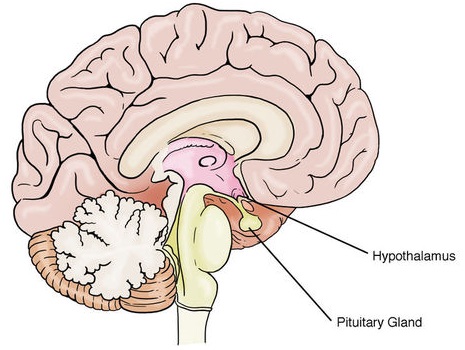
Structure and Function of the Pituitary Gland
The pituitary gland is about the size of a pea. It protrudes from the bottom of the hypothalamus at the base of the inner brain (Figure <span id=”MathJax-Element-3-Frame” class=”MathJax” style=”display: inline-table; font-style: normal; font-weight: normal; line-height: normal; font-size: 17.6px; text-indent: 0px; text-align: left; text-transform: none; letter-spacing: normal; word-spacing: normal; overflow-wrap: normal; white-space: nowrap; float: none; direction: ltr; max-width: none; max-height: none; min-width: 0px; min-height: 0px; border: 0px; padding: 0px; margin: 0px; position: relative;” tabindex=”0″ role=”presentation” data-mathml=”12.4.2″>12.4.2
12.4.2). The pituitary is connected to the hypothalamus by a thin stalk (called the infundibulum). Blood vessels and nerves in the stalk allow direct connections between the hypothalamus and the pituitary gland. The pituitary gland consists of two bulb-like lobes: an anterior lobe and a posterior lobe (Figure <span id=”MathJax-Element-4-Frame” class=”MathJax” style=”display: inline-table; font-style: normal; font-weight: normal; line-height: normal; font-size: 17.6px; text-indent: 0px; text-align: left; text-transform: none; letter-spacing: normal; word-spacing: normal; overflow-wrap: normal; white-space: nowrap; float: none; direction: ltr; max-width: none; max-height: none; min-width: 0px; min-height: 0px; border: 0px; padding: 0px; margin: 0px; position: relative;” tabindex=”0″ role=”presentation” data-mathml=”12.4.3″>12.4.3
12.4.3).
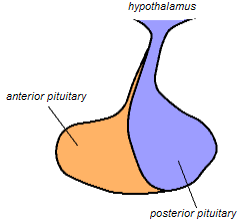
Anterior Lobe
The anterior pituitary is the lobe is at the front of the pituitary gland. It synthesizes and releases hormones into the blood. The table below shows some of the endocrine hormones released by the anterior pituitary, including their targets and effects.
| Hormone | Target | Effect(s) |
|---|---|---|
| Adrenocorticotropic hormone (ACTH) | Adrenal glands | Stimulates the cortex of each adrenal gland to secrete its hormones |
| Thyroid-stimulating hormone (TSH) | Thyroid gland | Stimulates the thyroid gland to secrete thyroid hormone |
| Growth hormone (GH) | Body cells | Stimulates body cells to synthesize proteins and grow |
| Follicle-stimulating hormone (FSH) | Ovaries, testes | Stimulates the ovaries to develop mature eggs; stimulates the testes to produce sperm |
| Luteinizing hormone (LH) | Ovaries, testes | Stimulates the ovaries and testes to secrete sex hormones; stimulates the ovaries to release eggs |
| Prolactin (PRL) | Mammary glands | Stimulates the mammary glands to produce milk |
The anterior pituitary gland is regulated mainly by hormones from the hypothalamus. The hypothalamus secretes hormones called releasing hormones and inhibiting hormones that travel through capillaries directly to the anterior lobe of the pituitary gland (you can see the capillary connection in the diagram above). The hormones stimulate the anterior pituitary to either release or stop releasing particular pituitary hormones. Several of these hypothalamic hormones and their effects on the anterior pituitary are shown in the table below.
|
Hypothalamic Hormone |
Effect on Anterior Pituitary |
|---|---|
|
Thyrotropin releasing hormone (TRH) |
Release of thyroid stimulating hormone (TSH) |
|
Corticotropin releasing hormone (CRH) |
Release of adrenocorticotropic hormone (ACTH) |
|
Gonadotropin releasing hormone (GnRH) |
Release of follicle-stimulating hormone (FSH) and luteinizing hormone (LH) |
|
Growth hormone releasing hormone (GHRH) |
Release of growth hormone (GH) |
|
Growth hormone inhibiting hormone (GHIH) (Somatostatin) |
Stopping of growth hormone release |
|
Prolactin releasing hormone (PRH) |
Release of prolactin |
|
Prolactin inhibiting hormone (PIH) (Dopamine) |
Stopping of prolactin release |
Posterior Lobe
The posterior pituitary is the lobe is at the back of the pituitary gland. This lobe does not synthesize any hormones. Instead, the posterior lobe stores hormones that come from the hypothalamus along the axons of nerves connecting the two structures (Figure <span id=”MathJax-Element-8-Frame” class=”MathJax” style=”display: inline-table; font-style: normal; font-weight: normal; line-height: normal; font-size: 17.6px; text-indent: 0px; text-align: left; text-transform: none; letter-spacing: normal; word-spacing: normal; overflow-wrap: normal; white-space: nowrap; float: none; direction: ltr; max-width: none; max-height: none; min-width: 0px; min-height: 0px; border: 0px; padding: 0px; margin: 0px; position: relative;” tabindex=”0″ role=”presentation” data-mathml=”12.4.3″>12.4.3
12.4.3). The posterior pituitary then secretes the hormones into the bloodstream as needed. Hypothalamic hormones secreted by the posterior pituitary include vasopressin and oxytocin.
- Vasopressin (also called antidiuretic hormone, or ADH) helps to maintain homeostasis in body water. It stimulates the kidneys to conserve water by producing more concentrated urine. Specifically, vasopressin targets ducts in the kidneys and makes them more permeable to water. This allows more water to be resorbed by the body rather than excreted in the urine.
- Oxytocin (OXY) targets cells in the uterus to stimulate uterine contractions, for example, during childbirth. It also targets cells in the breasts of a nursing mother to stimulate the letdown of milk.
Adrenal Glands
Introduction to the Adrenal Glands
The adrenal glands are endocrine glands that produce a variety of hormones. Adrenal hormones include the fight-or-flight hormone adrenaline and the steroid hormone cortisol. The two adrenal glands are located on both sides of the body, just above the kidneys, as shown in Figure <span id=”MathJax-Element-2-Frame” tabindex=”0″ role=”presentation” data-mathml=”12.6.2″>12.6.2
12.6.2. The right adrenal gland (on the left in the figure) is smaller and has a pyramidal shape. The left adrenal gland (on the right in the figure) is larger and has a half-moon shape.
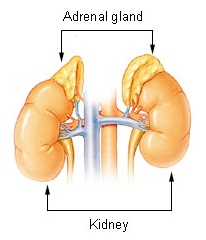
Each adrenal gland has two distinct parts, and each part has a different function, although both parts produce hormones. There is an outer layer, called the adrenal cortex, which produces steroid hormones including cortisol. There is also an inner layer, called the adrenal medulla, which produces non-steroid hormones including adrenaline.
Adrenal Cortex
The adrenal cortex, or outer layer of the adrenal gland, is divided, in turn, into three additional layers, called zones (see figure below). Each zone has distinct enzymes that produce different hormones from the common precursor molecule cholesterol, which is a lipid.
- Zona glomerulosa is the outermost layer of the adrenal cortex. It lies immediately under the outer fibrous capsule that encloses the adrenal gland.
- Zona fasciculata is the middle layer of the adrenal cortex. It is the largest of the three zones, accounting for nearly 80 percent of the adrenal cortex.
- Zona reticularis is the innermost layer of the adrenal cortex. It is directly adjacent to the medulla of the adrenal gland.
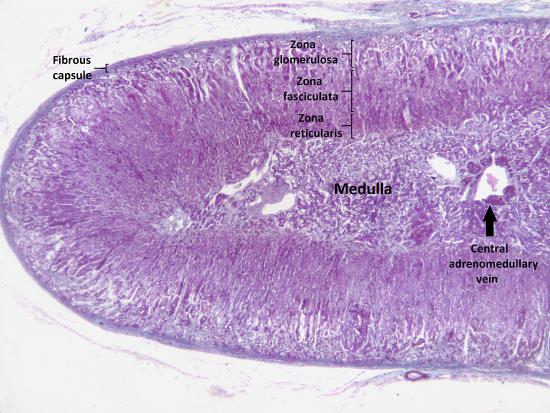
Types of Adrenal Cortex Hormones
Hormones produced by the adrenal cortex are called by the general term corticosteroids. As steroid hormones, corticosteroids are endocrine hormones that are made of lipids and exert their effects on target cells by crossing the plasma membrane and binding with receptors within the cytoplasm. A steroid hormone and its receptor form a complex that enters the cell nucleus and affects gene expression. There are three types of corticosteroids synthesized and secreted by the adrenal cortex. Each type is produced by a different zone of the adrenal cortex, as shown in Figure <span id=”MathJax-Element-5-Frame” tabindex=”0″ role=”presentation” data-mathml=”12.6.4″>12.6.4
12.6.4.
Mineralocorticoids
Mineralocorticoids are produced in the zona glomerulosa and include the hormone aldosterone. These hormones help control the balance of mineral salts (electrolytes) in the body. In the kidneys, aldosterone increases the reabsorption of sodium ions and the excretion of potassium ions. Aldosterone also stimulates the retention of sodium ions by cells in the colon and by the sweat glands. The amount of sodium in the body affects the volume of extracellular fluids including the blood and thereby affects blood pressure. In this way, mineralocorticoids help control blood volume and blood pressure.
Glucocorticoids
Glucocorticoids are produced in the zona fasciculata and include the hormone cortisol, which is released in response to stress and is considered the primary stress hormone. Glucocorticoids help control the rate of metabolism of proteins, fats, and sugars. In general, they increase the level of glucose and fatty acids circulating in the blood. Cells rely primarily on glucose for energy, but they can also use fatty acids for energy as an alternative to glucose. Glucocorticoids are also involved in suppression of the immune system, having a potent anti-inflammatory effect. In addition, cortisol reduces the production of new bone and decreases the absorption of calcium from the gastrointestinal tract.
Androgens
Androgens are produced in the zona reticularis and include the hormone DHEA (dehydroepiandrosterone). Androgens are a general term for male sex hormones, although this is somewhat misleading as adrenal cortex androgens are produced by both males and females. In adult males, they are converted to more potent androgens such as testosterone in the male gonads (testes). In adult females, they are converted to female sex hormones called estrogens in the female gonads (ovaries).

Regulation of Adrenal Cortex Hormones
Steroid hormone production by the three zones of the adrenal cortex is regulated by hormones secreted by the anterior lobe of the pituitary gland as well as by other physiological stimuli. For example, the production of glucocorticoids such as cortisol is stimulated by adrenocorticotropic hormone (ACTH) from the anterior pituitary, which in turn is stimulated by corticotropin releasing hormone (CRH) from the hypothalamus. When levels of glucocorticoids start to rise too high, they provide negative feedback to the hypothalamus and pituitary gland to stop secreting CRH and ACTH, respectively. This negative feedback mechanism is illustrated in the figure below. The opposite occurs when levels of glucocorticoids start to fall too low.
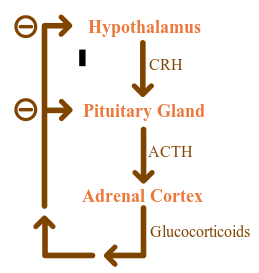
Adrenal Medulla
The adrenal medulla is at the center of each adrenal gland and is surrounded by the adrenal cortex. It contains a dense network of blood vessels into which it secretes its hormones. The hormones synthesized and secreted by the adrenal medulla are called by the general term catecholamines, and they include adrenaline (also called epinephrine) and noradrenaline (also called norepinephrine). These are water-soluble, non-steroid hormones are made of amino acids. As non-steroid hormones, they cannot cross the plasma membrane of target cells. Instead, they exert their effects by binding to receptors on the surface of target cells. Binding of hormone and receptor activates an enzyme in the plasma membrane that controls a second messenger. It is the second messenger that influences processes inside the cell.
Catecholamines function to produce a rapid response throughout the body in stressful situations. They bring about such changes as increased heart rate, more rapid breathing, constriction of blood vessels in certain parts of the body, and an increase in blood pressure. The release of catecholamines by the adrenal medulla is stimulated by activation of the sympathetic division of the autonomic nervous system.
Disorders of the Adrenal Glands
Disorders of the adrenal glands generally include either hypersecretion or hyposecretion of adrenal hormones. The underlying cause of the abnormal secretion may be a problem with the adrenal glands or with the pituitary gland, which controls adrenal cortex hormone production. Both adrenal and pituitary glands are subject to the formation of tumors, which may cause adrenal disorders. The adrenal gland may also be affected by infections or autoimmune diseases.
Adrenal Hypersecretion: Cushing’s Syndrome
Hypersecretion of the glucocorticoid hormone cortisol leads to a disorder named Cushing’s syndrome. The most common cause of Cushing’s syndrome is a pituitary tumor, which causes excessive production of ACTH. The disease produces a wide variety of signs and symptoms, which may include obesity, diabetes, high blood pressure (hypertension), excessive body hair, osteoporosis, and depression. A distinctive sign of Cushing’s syndrome is the appearance of stretch marks in the skin, as the skin becomes progressively thinner. Another distinctive sign is a moon face shown in the section Introduction to the Endocrine System, in which fat deposits give the face a rounded appearance. Treatment of Cushing’s syndrome depends on its cause and may include surgery to remove a tumor or medications to suppress the activity of the adrenal glands.
Adrenal Hyposecretion: Addison’s Disease

Hyposecretion of the glucocorticoid hormone cortisol leads to a disorder named Addison’s disease. There may also be hyposecretion of mineralocorticoids with this disorder. Addison’s disease is generally an autoimmune disorder, in which the immune system produces abnormal antibodies that attack cells of the adrenal cortex. Untreated infections, especially of tuberculosis, may also damage the adrenal cortex and cause Addison’s disease. A third possible cause is the decreased output of ACTH by the pituitary gland, generally due to a pituitary tumor. A distinctive sign of Addison’s disease is hyperpigmentation of the skin (Figure 12.6.6). Other symptoms tend to be nonspecific and include excessive fatigue. Addison’s disease is generally treated with replacement hormones in pill form.
watch
Learn more about the effects of stress and cortisol on the brain here:
What is Diabetes?
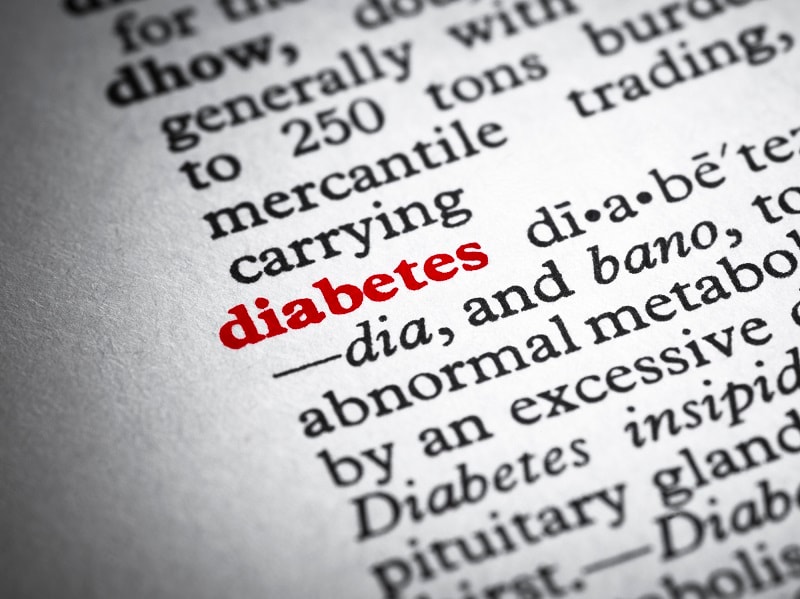
With diabetes, your body either doesn’t make enough insulin or can’t use it as well as it should.
Diabetes is a chronic (long-lasting) health condition that affects how your body turns food into energy.
Most of the food you eat is broken down into sugar (also called glucose) and released into your bloodstream. When your blood sugar goes up, it signals your pancreas to release insulin. Insulin acts like a key to let the blood sugar into your body’s cells for use as energy.
If you have diabetes, your body either doesn’t make enough insulin or can’t use the insulin it makes as well as it should. When there isn’t enough insulin or cells stop responding to insulin, too much blood sugar stays in your bloodstream. Over time, that can cause serious health problems, such as heart disease, vision loss, and kidney disease.
There isn’t a cure yet for diabetes, but losing weight, eating healthy food, and being active can really help. Taking medicine as needed, getting diabetes self-management education and support, and keeping health care appointments can also reduce the impact of diabetes on your life.
- 34.2 million US adults have diabetes, and 1 in 5 of them don’t know they have it.
- Diabetes is the seventh leading cause of death in the United States.
- Diabetes is the No. 1 cause of kidney failure, lower-limb amputations, and adult blindness.
- In the last 20 years, the number of adults diagnosed with diabetes has more than doubled.
Types of Diabetes
There are three main types of diabetes: type 1, type 2, and gestational diabetes (diabetes while pregnant).
Type 1 Diabetes
Type 1 diabetes is thought to be caused by an autoimmune reaction (the body attacks itself by mistake) that stops your body from making insulin. Approximately 5-10% of the people who have diabetes have type 1. Symptoms of type 1 diabetes often develop quickly. It’s usually diagnosed in children, teens, and young adults. If you have type 1 diabetes, you’ll need to take insulin every day to survive. Currently, no one knows how to prevent type 1 diabetes.
Type 2 Diabetes
With type 2 diabetes, your body doesn’t use insulin well and can’t keep blood sugar at normal levels. About 90-95% of people with diabetes have type 2. It develops over many years and is usually diagnosed in adults (but more and more in children, teens, and young adults). You may not notice any symptoms, so it’s important to get your blood sugar tested if you’re at risk. Type 2 diabetes can be prevented or delayed with healthy lifestyle changes, such as losing weight, eating healthy food, and being active.
Gestational Diabetes
Gestational diabetes develops in pregnant women who have never had diabetes. If you have gestational diabetes, your baby could be at higher risk for health problems. Gestational diabetes usually goes away after your baby is born but increases your risk for type 2 diabetes later in life. Your baby is more likely to have obesity as a child or teen, and more likely to develop type 2 diabetes later in life too.
Prediabetes
In the United States, 88 million adults—more than 1 in 3—have prediabetes. What’s more, more than 84% of them don’t know they have it. With prediabetes, blood sugar levels are higher than normal, but not high enough yet to be diagnosed as type 2 diabetes. Prediabetes raises your risk for type 2 diabetes, heart disease, and stroke. The good news is if you have prediabetes, a CDC-recognized lifestyle change program can help you take healthy steps to reverse it.
Explore more
For a funny and fast-paced lesson that covers endocrine hormones in greater detail, watch this CrashCourse video:
Candela Citations
- Introduction to the Endocrine System. Authored by: Contributed by Suzanne Wakim & Mandeep Grewal Professors (Cell Molecular Biology & Plant Science) at Butte College. Located at: https://bio.libretexts.org/Bookshelves/Human_Biology/Book%3A_Human_Biology_(Wakim_and_Grewal)/12%3A_Endocrine_System/12.2%3A_Introduction_to_the_Endocrine_System. License: CC BY-NC: Attribution-NonCommercial
- What is Diabetes?. Authored by: U.S. Department of Health & Human Services. Provided by: Content source: Centers for Disease Control and Prevention. Located at: https://www.cdc.gov/diabetes/basics/diabetes.html. License: All Rights Reserved
